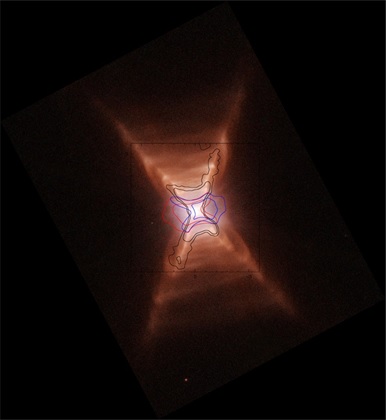Observatorio Astronómico Nacional
Infraestructura científica con más de 200 años

Estrellas evolucionadas
La mayoría de las estrellas muere tras eyectar casi toda su masa, conviertiéndose en espectaculares y extensas nebulosas; nuestro Sol así lo hará también. Los astrónomos del OAN trabajan activamente en el estudio de estas últimas fases de la evolución estelar.
Cuando una estrella normal envejece, sufre una gran expansión, su radio se hace tan grande que englobaría (calcinándolo) un planeta que girara con la órbita de la Tierra. A estas estrellas, que son ahora relativamente frías, se les llama gigantes rojas. La evolución posterior a esta fase es precisamente la más espectacular de la vida de la mayoría de las estrellas. Las gigantes rojas pierden masa de forma muy copiosa, y este proceso tiende a aumentar con el tiempo. Cuando la estrella ha eyectado la mayor parte de su masa, queda al descubierto el pequeño núcleo central. En sólo 1000 o 2000 años la estrella pasa de ser una gigante roja, fría y muy dilatada, a ser extraordinariamente compacta y caliente, una enana azul o blanca.
Estas estrellas enanas están aún rodeadas por el material previamente expulsado que, ahora iluminado y calentada por el residuo estelar, se llama nebulosa planetaria (por razones históricas, aunque no tiene nada que ver con los planetas). Las nebulosas planetarias se encuentran ellas mismas en vertiginosa evolución, con importantes procesos de interacción dinámica entre las diferentes fases del viento estelar, que terminan dando lugar a las bellas imágenes que a menudo presentan. La estrellas viejas se convierten así en extensas nebulosas.
Concretamente destacamos nuestros estudios sobre :
- La estructura de las envolturas alrededor de gigantes rojas y las abundancias químicas en ellas, tanto en general como en objetos destacados.
- La estructura y química de las nebulosas planetarias. Ha sido particularmente relevante nuestro estudio de sus componentes más frías, que normalmente contienen la mayor parte del material nebular.
- La estructura y dinámica de las nebulosas planetarias muy jóvenes. Citemos los trabajos acerca de la interacción de vientos, las ondas de choque asociadas y los efectos que en esta fase tiene la presencia de binariedad.




